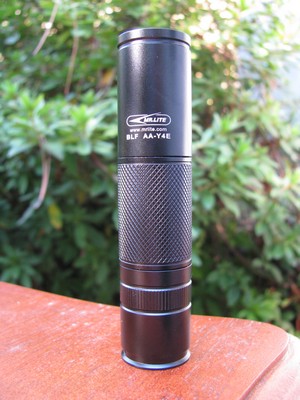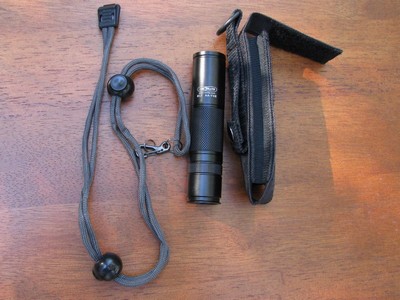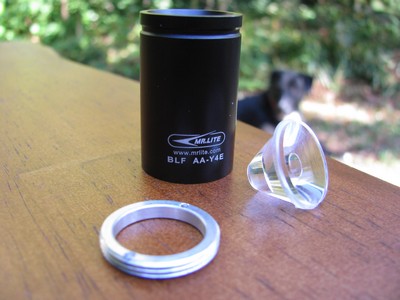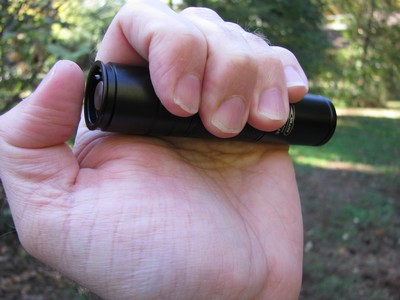Review: Mr.Lite BLF AA-4YE
Summary:
| Battery: | AA/14500 |
| Switch: | Reverse clicky |
| Modes: | 4 |
| LED Type: | Cree XR-E Q5 |
| Lens: | Collimator (plastic) |
| Tailstands: | Yes |
| Price Paid: | $16.99 |
| From: | Manafont |
| Date Ordered: | 25 Oct 2010 |
Pros:
- Well made
- Smooth threads
- Very good throw
- No flashy modes
- Nice holster and lanyard
Cons:
- Needed some repairs to work
- No mode memory
- Two low modes are too close together
- Without lanyard it will roll
Features / Value: 4 out of 5
After hearing a lot about Mr.Lite flashlights and Manafont, forces were brought together for this customized version of the Mr.Lite J4 resulting in the Mr.Lite BLF AA-Y4E. It's basically a Mr.Lite J4, except the modes were picked by Mr. Admin based on polling results taken here at Budget Light Forum. In order to please those who like a super low Low and those who want a more usable Low, this light has two lows, Moonlight and Low. However the two modes are actually pretty close and the lowest setting is not a true Moonlight mode (less than 1 lumen).
It was fun to get our own light. You can read about the light in this thread and see whether people opted for black, silver, or both in this poll.
Originally the light was to come in retail packaging, but that got messed up and Manafont did a nice job of protecting the light, putting it in its holster then wrapping it and the lanyard in buble wrap, secured in tape, and then the whole thing was in a padded envelope. The holster has a carrying loop, a belt loop with a snap, and a velcro flap to keep the light secured in the holster. The lanyard is paracord with some adjustment beads and a clip with a split ring, but I don't know how I could get that split ring through both holes in the tail of the light. If you only put it through one hole, then it won't tailstand correctly. I may be able to get a slight smaller split ring which might be able to get through both holes.
NOTE: All of the pictures (except the beam shots) can be clicked on to open a version twice as large.
The body tube fits an AA quite well. I could barely fit a flame Trustfire lithium-ion battery, but those batteries run a little long and won't fit at all in a couple of my other lights. The body tube itself is thicker than most lights. I imagine Mr.Lite will be able to use the same head and tail and swap out the body tube for a CR123A or 18650 light. This makes the light more substantial than other AA lights, but in a good way and it still fits fine in a pocket.
The price isn't too bad for such a well-made customized light that also includes decent pack-ins. It's worth a couple of dollars just to avoid any strobes.The LED is a Cree XR-E with a Q5 bin. This is an older LED, but a good one that is still popular in budget lights especially where throw is desired. While a lot of lights have aluminum reflectors, this light has a plastic collimating lens that provides a small hotspot that throws quite well, better than my lights with reflectors. In Medium and High, the light takes a second to ramp up to full brightness, maybe like a slide coming on. It's not a bad effect. In the Low modes I can barely hear some buzzing from the PWM, but I only noticed it after someone else pointed it out. At least it isn't a high-pitched whine.
Build Quality: 3 out of 5
The build quality of the body is quite good, but I have to really knock the light for not working. It looks good, the light knurling and surface design looks very good, and the body tube itself is very thick. The o-rings were lubed properly and the threads are just butter smooth. The reverse clicky is metal and I'm not crazy about it. It feels like clicking a ball point pen and rattles just a little. I don't see how it could be waterproof so it might defeat the o-rings elsewhere.
Inside the light there is an aluminum pill with a full-size 17mm driver. I'd rather see a brass pill, but aluminum is fine too and my AKOray K-106 has an aluminum pill too. It was no problem backing the pill out (there are notches in the pill so you can get a grip with needle nose pliers) and again the threads are very smooth. The driver on my light was not soldered to the pill so I tried to dislodge the driver and get a picture of it, but there was not enough slack in the leads from the driver to the LED itself and I couldn't get a good look at the driver without unsoldering the leads. This lens is held in the head of the light by a threaded ring, so it is very secure. But there is no o-ring in front of the lens like lights with flat glass lenses usually have.
In the tail end of the battery compartment there is a piston instead of just a regular spring, which is a nice feature. It is pretty stiff though. The spring mounted to the driver is soldered on in two places and is so solid I was able to unscrew the pill by turning the spring. Here is the spring and the soldering I applied (the foreground blob works, I could never get the longer blob to bridge to the pill) to get a good electrical connection between the pill (which completes the contact between the negative end of the battery via the tail piston and body tube):
Comparison of barrel thicknesses (AKOray K-106, Uniquefire S10, Mr.Lite BLF AA-Y4E, Fenix L1D)
Battery Life: 4 out of 5
I did a run test using NiMH and then a lithium-ion battery. The way I test, which isn't totally accurate is I measure the battery voltage at rest, and then measure the tail current. I then run the light for 10 minutes, turn it off, and repeat the measurements. During the test the light barely got warm even though there was a pretty good current draw. I got an hour of good light.
| Time (hr:min) | Battery (V) | Moon (mA) | Low (mA) | Med (mA) | High (mA) |
| 0:00 | 1.490 | 40 | 70 | 410 | 2040 |
| 0:10 | 1.288 | 40 | 60 | 370 | 1700 |
| 0:20 | 1.243 | 40 | 60 | 400 | 1780 |
| 0:30 | 1.222 | 40 | 60 | 380 | 1750 |
| 0:40 | 1.197 | 40 | 60 | 390 | 1730 |
| 0:50 | 1.160 | 40 | 60 | 360 | 1650 |
| 1:00 | 1.041 | 40 | 50 | 320 | 1200 |
| 1:10 | 0.873 | 40 | 50 | 210 | 500 |
On a flame Trustfire 900mAh lithium-ion battery I got 35 minutes of total runtime. The light got warmer, but not hot. I had a hard time getting consistent readings with my meter on High. I'm not sure if that is the driver, but I'll be interested to see Don's runtime graphs to see if there is an oscillation. It probably settles in after a few seconds, so maybe a graph won't show it.
| Time (hr:min) | Battery (V) | Moon (mA) | Low (mA) | Med (mA) | High (mA) |
| 0:00 | 4.18 | 20 | 40 | 240 | 1250 |
| 0:10 | 3.91 | 20 | 40 | 240 | 1060 |
| 0:20 | 3.77 | 20 | 40 | 250 | 1120 |
| 0:30 | 3.67 | 20 | 40 | 270 | 1160 |
| 0:35 | 3.48 | 20 | 40 | 280 | 1330 |
Light Output: 5 out of 5
The light output seems good, but it is hard to make a comparison because this light is geared toward throwing a small concentrated beam while other lights have a more dispersed hotspot. The pictures will bear that out pretty well and the BLF compares quite favorably. First there are some comparisons using a 2000mAh Eneloop NiMH. First I'll compare it with the Fenix L1D which uses the same LED, a Cree XR-E Q5 but has a smooth reflector. In these pictures the lights are 50cm from the wall and the BLF AA-Y4E is always on the left.
First both lights on High, using NiMH batteries, with the exposure at 1/25th second and ISO 100. The L1D has a somewhat neutral tint. The BLF is more of a cool white or maybe outdoor white, though not as blue as it looks here:
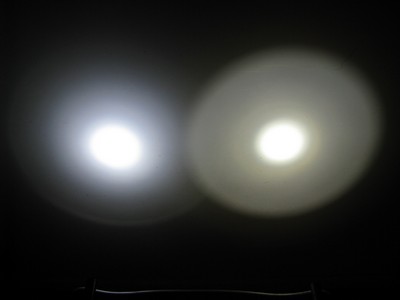
Now at 1/200th second:
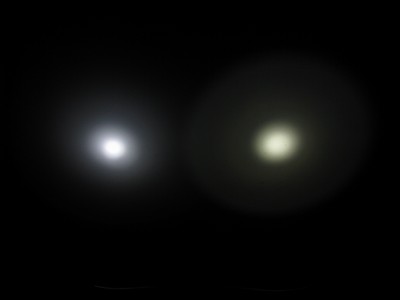
Now at 1/1600th second. The BLF has a more intense hotspot:
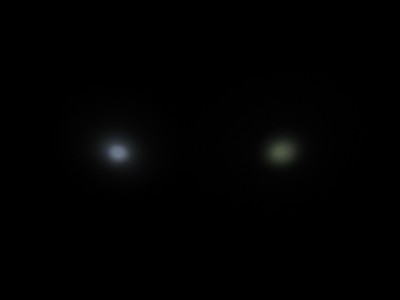
Here is a comparison of both of these lights on their lowest settings, taken at 1/25th second. The Fenix is advertised as being 12 lumens on Low, so the BLF is significantly less than that.
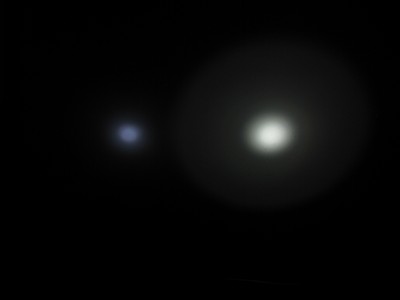
Now to compare the light against the iTP A3 EOS. This light is much smaller, using a AAA battery, and can't concentrate the beam like the L1D. It also has a different LED, a Cree XP-E, but the same brightness bin of Q5. So here are both lights on High with NiMH eneloops at 1/25th second:
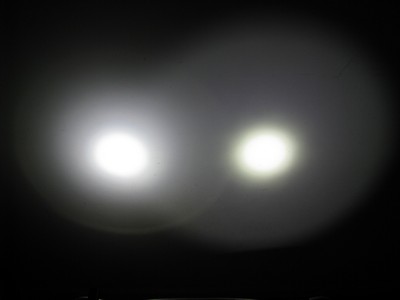
Now at 1/200th second you can really see the difference in the beam patterns:
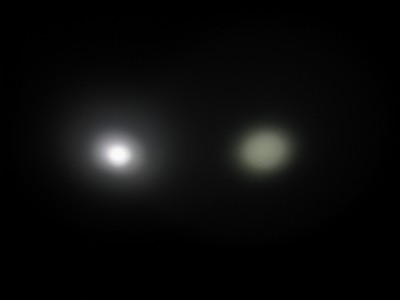
And at 1/1600th second:

Now here are both lights on Low at 1/25th second. The iTP advertises a Low of only 1.5 lumens and I think the Y4E is a little bit higher, so maybe 2-3 lumens:

Here are two more shots comparing Moonlight mode and Low against the A3. This time the photos are taken at 1/5 second to exaggerate the brightness. Here is Moonlight:
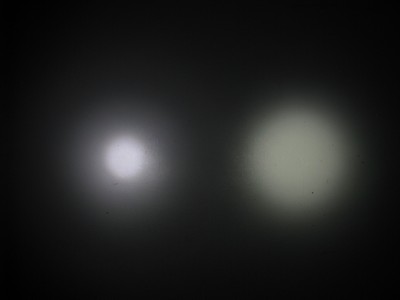
Now on Low. There is a distinct difference, but it's not much:

In attempting to get a moonlight mode, they really cranked up the PWM on Low. Here is a time exposure of BLF on the left vs. the original iTP A3 EOS, both on their lowest settings. I was moving both lights pretty fast up and down, but at the same speed, and you can see by the dots being spaced out further with the BLF that its PWM has a lower frequency. The stainless steel AAA Trustfire XP-E F23 has about the same PWM as the iTP. Later models of the A3 really improved the PWM.
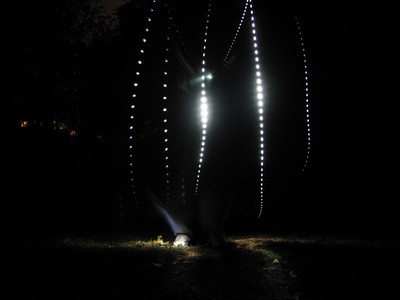
Now I will do some comparisons using a lithium-ion battery, fully charged to almost 4.2 volts. First here is the Y4E against my Uniquefire S10 which has a Cree XR-E R2 (should be about 5% brighter than a Q5) running on direct drive off the battery:

Now at 1/200th second:
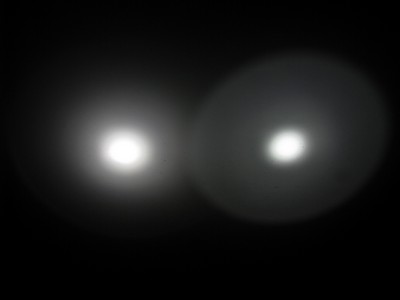
And at 1/1600th second. The Y4E has a more intense hotspot:
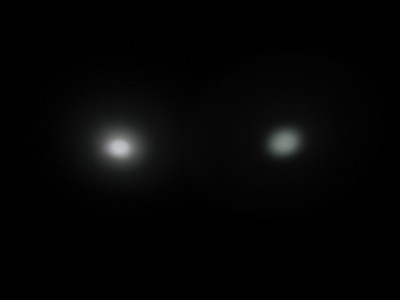
Now to go outdoors. All pictures are taken at a 3.2 second exposure to try to get a picture of how it looks to the eye. The potted plant is 25' from the camera and the lights are pointed at the fence posts which are 120' away. First the Y4E using a fresh Eneloop on Moonlight mode (essentially a control shot; in real life it barely shone light on the plant):
Now on Low, you still can't see anything in the picture:

Now on Medium you can start to make things out:
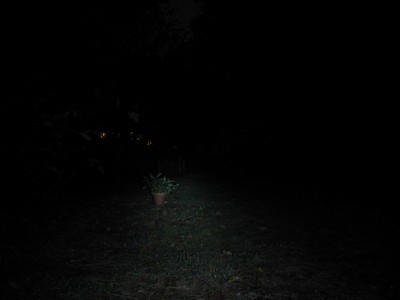
And on High you can see all the way to the fence posts:
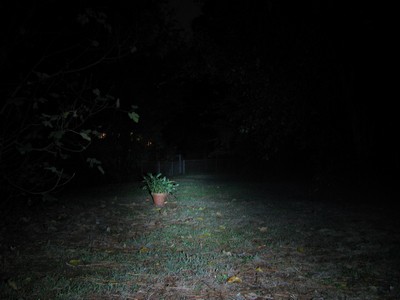
Now here is a comparison of the Fenix using NiMH on Turbo setting, doesn't throw as well:
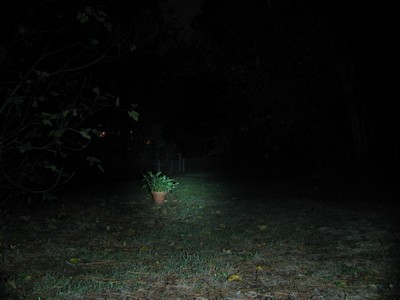
Now here is the iTP on NiMH at High, can't even see the fence posts:
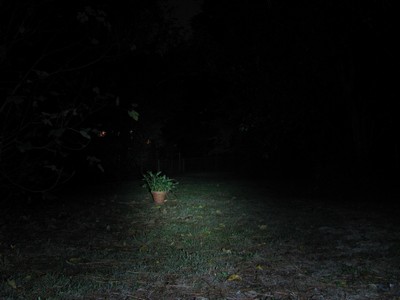
Swapping in a lithium-ion battery, the brightness and throw go way up. Here is the Y4E on li-ion:
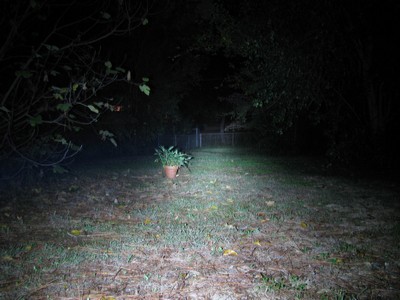
Now here is the direct driven Uniquefire S10 on li-ion:
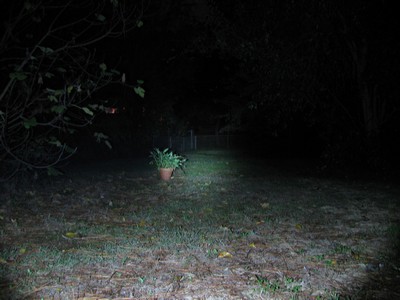
And the Fenix L1D on li-ion:
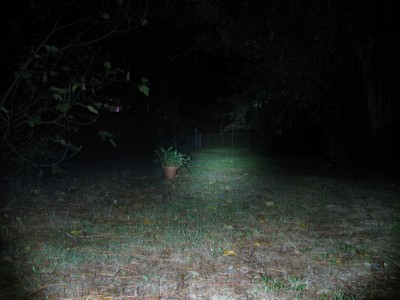
Now here's a detail of the fence cropped from the original full-size photo. The first row is the Y4E on NiMH and Li-ion. The second row is the S10 and L1D on li-ion. For throw, this light is hard to beat. In fact, on NiMH the throw is very close to what the other two lights are doing with a li-ion battery:
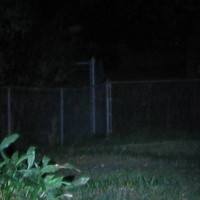
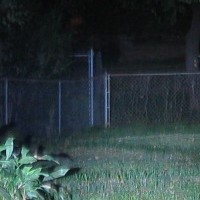
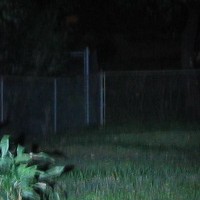
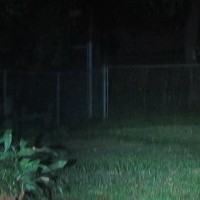
Summary: 3 out of 5
This is a pretty decent light, but not outstanding. I have to take off at least a star for the fact that it didn't work correctly without me soldering the driver board. That would take off all 5 stars for people who can't fix a light on their own. The light output is good. The light is geared towards throwing and does that pretty well, but I prefer a little larger hotspot. The metal tail switch is nice, but I'd prefer rubber and would feel more comfortable with it being watertight. The two Low modes being too close kind of make 4 modes pointless and just means you have to click an extra time to get to High. Also I think a light at this price should probably include mode memory. But I do like the fact that it has no flashy modes and that makes me more likely to recommend it to someone as long as I would be available to solder it if necessary.
